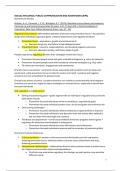Samenvatting
Summary all articles SIPA 2024 (Social Influence, Public Communication and Advertizing SIPA) - SHOP master UU
- Instelling
- Universiteit Utrecht (UU)
This summary contains the following articles: Scholer et al (2019), Berger (2020), Van Bavel & Packer (2021), Chater & Loewenstein (2023), Huta (2016), Schwartz (2012), Bolderdijk & Jans (2021) and Berger (2014) Master SHOP (Utrecht University) year 2024/2025 Exam: 2/12/2024
[Meer zien]




